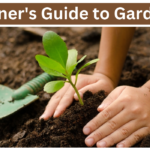A wide range of gardening tips and techniques that have survived the test of time and been shown to be successful in encouraging healthy plant growth and maximizing harvests are included in popular gardening techniques, These methods will help in Gardening for beginners at home.
Here are a few of the most widely used gardening techniques and methods:
1) Companion planting
Companion planting is the practice of putting various plants next to one another for mutual benefit. Some plants protect their neighbors from pests that would otherwise harm them, while others enhance soil fertility or give climbing plants support.
2) Hydroponic System
In a regulated atmosphere, the hydroponic system delivers all the vital nutrients needed for plant growth right to the roots. Although there are numerous varieties of hydroponic systems, the basic idea is the same: sustaining plant development with a nutrient solution rather than soil.
Here are a few typical hydroponic methods:
i) Deep Water Culture (DWC): Plants are floating in a nutritional solution with their roots submerged in deep water culture (DWC). Air stones or diffusers are used to deliver oxygen in order to prevent root rot and ensure healthy plant growth.
ii) Fertilizer Film Technique (NFT): NFT includes continuously running a thin layer of fertilizer solution over the plants’ bare roots, enabling them to absorb the necessary nutrients.
iii) Ebb and Flow (Flood and Drain): In this system, the nutrient solution periodically floods the root zone before being drained away. During the drainage phase, it supplies the roots with both nutrients and oxygen.
iv) Drip System: Using this technique, each plant’s base receives a controlled amount of fertilizer solution at regular intervals from a drip emitter.
v) Wick system: One of the simplest hydroponic systems is the wick system, in which a wick transports nutrient solution from a reservoir to the plant’s root zone.
vi) Aeroponics: In aeroponics, the roots of the plants are misted with a nutrient solution while they are suspended in the air. The roots receive the most oxygen with this technique.
In comparison to conventional soil-based production, hydroponics has advantages such as faster growth rates, higher yields, and efficient use of water and nutrients. Furthermore, hydroponics enables year-round production and can be used in indoor or greenhouse environments, giving growers better control over environmental variables like temperature, humidity, and light.
3) Gardening in raised beds
Raised beds are elevated garden areas that are enclosed by frames or borders. They facilitate soil drainage, prevent soil compaction, and facilitate weed and pest management. In regions with poor soil or little space, raised beds are very helpful.
4) Square Foot Gardening
Using this Technique, the garden is divided into small square parts. Depending on the plants’ needs for space, each square is then planted with a specified number of plants. It’s a system that saves space and makes planting and planning easier.
5) Intensive Gardening
In intensive gardening, crops are planted closely together to make the most of the available space. This decreases weed growth, saves water, and increases the overall productivity of the garden.
6) No-Dig Gardening
Also called “no-till” gardening, this approach avoids digging the soil by piling organic materials on top of it. It encourages a sound soil structure, inhibits soil erosion, and lessens the disruption of advantageous soil organisms.
7) Vertical gardening
Vertical gardening involves growing plants vertically by using vertical surfaces like walls or trellises. This method makes vining plants grow while enhancing the garden’s aesthetics and is perfect for tiny settings.
8) Succession Planting
Succession planting refers to the practice of planting fresh crops as soon as the old ones are harvested. This guarantees a consistent yield throughout the growing season and makes the best use of the space that is available.
9) Mulching
Using organic materials like leaves, straw, or wood chips, mulching includes covering the soil’s surface. Mulch aids in maintaining soil moisture, controlling weed growth, and maintaining soil temperature.
10) Crop Rotation
To prevent pests and illnesses from amassing in the soil, crop rotation involves shifting the area of crops each season. Plant groups have different nutrient requirements, therefore rotating crops helps keep the soil fertile.
11) Water-saving Methods
Water-saving methods like drip irrigation, soaker hoses, and rainwater collection assist reduce water waste and maintain plants’ proper hydration.
12) Composting
Composting is the process of turning organic kitchen and garden waste into compost that is high in nutrients. Compost increases microbial activity, improves soil fertility, and lessens the demand for artificial fertilizers.
13) Pruning and Training
In this technique, Plants are given shape, dead or diseased growth is removed, and the growth of plants is guided to improve their form and production.
Author: These popular gardening practices can be modified to fit the size, temperature, and tastes of your own garden. To produce a flourishing and fruitful garden, try out several techniques and figure out which ones work best for you.










